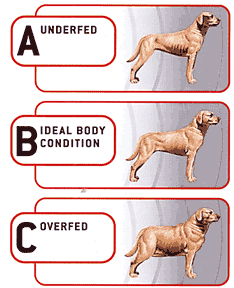If there was a disease that could cost you precious time with your dog, you’d want to know what it is and how to avoid it, right? I’m going to share with you an issue that is common in dogs that can easily be prevented which will save suffering as well as cost and time. I bet I have your attention now!
That issue is obesity.
What is Obesity?
Obesity is an accumulation of excess body fat which generally translates to extra body weight. When a dog weighs more than 20% over their ideal body weight, they are considered to be obese. Obesity is the most common and preventable disease afflicting dogs in the United States.
In a 2018 survey on dog and cat obesity, 36.9% of dogs were classified as overweight and 18.9% of dogs were classified as obese. This was a slight increase from the 2017 study and an estimated 50 million dogs. The issue is pervasive. So, if you have an overweight or obese dog, you’re not alone. A significant number of dogs are in the same boat right along with yours.
How Does Obesity Happen?
Dogs often become obese gradually, where an owner may notice the dog has gained a few pounds and then may notice the dog is a bit less active than it used to be. Feeding an excess amount of food for the dog’s activity level is ultimately what contributes to the condition and the dog that is chubby or plump can slide into obesity.
Often it’s a mindset issue with owners, where people think that if their dog is “fat and happy” it means they are taking good care of their dog. While these owners’ intentions may be wonderful, allowing a dog to become obese is not. It’s not cute but sadly, obesity poses a significant health risk.
What are the Risks for Your Dog with Obesity?
Obesity shortens your dog’s life. It’s generally accepted that overweight dogs live shorter lives by 6 to 12 months. However, a lifetime study of Labrador Retrievers was done that shows being even moderately overweight can reduce a dog’s life expectancy by nearly two years. Let that sink in for a moment: You could lose up to two years of time with your dog if they are moderately overweight.
Obesity is now believed to cause an inflammatory response in your dog, or said another way, it’s a chronic, low-level inflammatory condition. Obese dogs are at an increased risk for:
How to Know if Your Dog is Overweight.
You should be able to see and feel your dog’s ribs if they are at a healthy weight. You should also be able see and feel their waist and it should taper in when viewed from above. If either of those doesn’t hold true, then your dog is overweight and should likely lose some weight. And before you think your dog isn’t overweight because their legs aren’t chunky, I’m sorry to say that’s not where they store fat. It’s typically found in their chest, belly, and hips.
What You Can Do if Your Dog is Overweight.
The good news about obesity is that there are things you can do to help your dog live a happier and healthier life. It’s not always easy, but you absolutely can turn things around.
If your dog doesn’t pass these checks or if you are unsure, make an appointment with your primary vet. A physical exam and diagnostics like blood work will help your vet determine if there are any secondary health issues resulting from the excess weight.
Then, come to see me! I can work with you on an exercise regime that will help your dog stay active and strong. It’s not all about work as it’s important that you both have fun to keep up the momentum. And it’s also not only about activity. If your dog is not on a prescription diet, I can do a review of macronutrients and calories (protein, fat, carbs) of what you are currently feeding to help with simple adjustments.
In upcoming posts, I’ll write about some tips to help your dog on the path back to fitness and health including exercise and diet and ways to maintain once you’re there.
Obesity in dogs is a problem that can decrease the quality and quantity of your dog’s life. There is hope and there are things that you can do to make a huge difference. You absolutely can turn it around and your dog will thank you.
That issue is obesity.
What is Obesity?
Obesity is an accumulation of excess body fat which generally translates to extra body weight. When a dog weighs more than 20% over their ideal body weight, they are considered to be obese. Obesity is the most common and preventable disease afflicting dogs in the United States.
In a 2018 survey on dog and cat obesity, 36.9% of dogs were classified as overweight and 18.9% of dogs were classified as obese. This was a slight increase from the 2017 study and an estimated 50 million dogs. The issue is pervasive. So, if you have an overweight or obese dog, you’re not alone. A significant number of dogs are in the same boat right along with yours.
How Does Obesity Happen?
Dogs often become obese gradually, where an owner may notice the dog has gained a few pounds and then may notice the dog is a bit less active than it used to be. Feeding an excess amount of food for the dog’s activity level is ultimately what contributes to the condition and the dog that is chubby or plump can slide into obesity.
Often it’s a mindset issue with owners, where people think that if their dog is “fat and happy” it means they are taking good care of their dog. While these owners’ intentions may be wonderful, allowing a dog to become obese is not. It’s not cute but sadly, obesity poses a significant health risk.
What are the Risks for Your Dog with Obesity?
Obesity shortens your dog’s life. It’s generally accepted that overweight dogs live shorter lives by 6 to 12 months. However, a lifetime study of Labrador Retrievers was done that shows being even moderately overweight can reduce a dog’s life expectancy by nearly two years. Let that sink in for a moment: You could lose up to two years of time with your dog if they are moderately overweight.
Obesity is now believed to cause an inflammatory response in your dog, or said another way, it’s a chronic, low-level inflammatory condition. Obese dogs are at an increased risk for:
- Hypertension (high blood pressure)
- Diabetes mellitus
- Heart disease
- Many types of cancer
- Osteoarthritis
- Urinary bladder stones
- Complications under anesthesia
- Increased risk of injury
How to Know if Your Dog is Overweight.
You should be able to see and feel your dog’s ribs if they are at a healthy weight. You should also be able see and feel their waist and it should taper in when viewed from above. If either of those doesn’t hold true, then your dog is overweight and should likely lose some weight. And before you think your dog isn’t overweight because their legs aren’t chunky, I’m sorry to say that’s not where they store fat. It’s typically found in their chest, belly, and hips.
What You Can Do if Your Dog is Overweight.
The good news about obesity is that there are things you can do to help your dog live a happier and healthier life. It’s not always easy, but you absolutely can turn things around.
If your dog doesn’t pass these checks or if you are unsure, make an appointment with your primary vet. A physical exam and diagnostics like blood work will help your vet determine if there are any secondary health issues resulting from the excess weight.
Then, come to see me! I can work with you on an exercise regime that will help your dog stay active and strong. It’s not all about work as it’s important that you both have fun to keep up the momentum. And it’s also not only about activity. If your dog is not on a prescription diet, I can do a review of macronutrients and calories (protein, fat, carbs) of what you are currently feeding to help with simple adjustments.
In upcoming posts, I’ll write about some tips to help your dog on the path back to fitness and health including exercise and diet and ways to maintain once you’re there.
Obesity in dogs is a problem that can decrease the quality and quantity of your dog’s life. There is hope and there are things that you can do to make a huge difference. You absolutely can turn it around and your dog will thank you.



 RSS Feed
RSS Feed